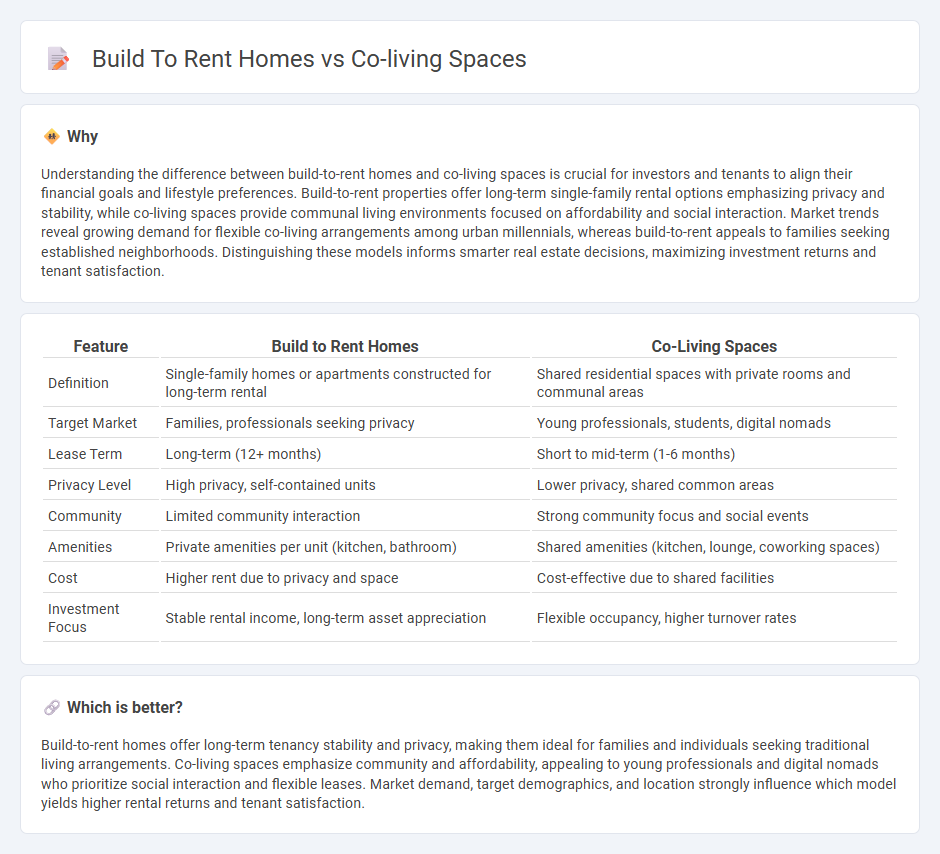
Build-to-rent homes offer private, fully owned residences designed specifically for long-term tenants, combining the advantages of homeownership with the flexibility of renting, often found in suburban or urban developments. Co-living spaces emphasize shared living arrangements with communal amenities and social partnerships, catering primarily to young professionals and digital nomads seeking affordability and community. Explore the benefits and considerations of build-to-rent homes versus co-living spaces to determine the best fit for your lifestyle and investment needs.
Why it is important
Understanding the difference between build-to-rent homes and co-living spaces is crucial for investors and tenants to align their financial goals and lifestyle preferences. Build-to-rent properties offer long-term single-family rental options emphasizing privacy and stability, while co-living spaces provide communal living environments focused on affordability and social interaction. Market trends reveal growing demand for flexible co-living arrangements among urban millennials, whereas build-to-rent appeals to families seeking established neighborhoods. Distinguishing these models informs smarter real estate decisions, maximizing investment returns and tenant satisfaction.
Comparison Table
| Feature | Build to Rent Homes | Co-Living Spaces |
|---|---|---|
| Definition | Single-family homes or apartments constructed for long-term rental | Shared residential spaces with private rooms and communal areas |
| Target Market | Families, professionals seeking privacy | Young professionals, students, digital nomads |
| Lease Term | Long-term (12+ months) | Short to mid-term (1-6 months) |
| Privacy Level | High privacy, self-contained units | Lower privacy, shared common areas |
| Community | Limited community interaction | Strong community focus and social events |
| Amenities | Private amenities per unit (kitchen, bathroom) | Shared amenities (kitchen, lounge, coworking spaces) |
| Cost | Higher rent due to privacy and space | Cost-effective due to shared facilities |
| Investment Focus | Stable rental income, long-term asset appreciation | Flexible occupancy, higher turnover rates |
Which is better?
Build-to-rent homes offer long-term tenancy stability and privacy, making them ideal for families and individuals seeking traditional living arrangements. Co-living spaces emphasize community and affordability, appealing to young professionals and digital nomads who prioritize social interaction and flexible leases. Market demand, target demographics, and location strongly influence which model yields higher rental returns and tenant satisfaction.
Connection
Build to rent homes and co-living spaces share a common goal of addressing the growing demand for flexible, affordable urban housing by providing professionally managed, community-oriented living environments. Both concepts leverage scalable construction techniques and emphasize shared amenities, fostering social interaction while optimizing space efficiency. This connection supports a shift in real estate investment strategies focusing on long-term occupancy and sustainable income streams.
Key Terms
Communal Amenities
Co-living spaces often feature shared kitchens, lounges, and coworking areas designed to foster community interaction and social engagement, appealing to young professionals and digital nomads. Build-to-rent homes typically offer private living quarters complemented by communal amenities such as fitness centers, swimming pools, and landscaped gardens, aimed at long-term renters seeking comfort and convenience. Explore the distinct benefits of communal amenities in co-living and build-to-rent models to find the best fit for your lifestyle.
Lease Structure
Co-living spaces typically offer short-term, flexible leases with shared amenities and communal living arrangements, appealing to young professionals and transient residents seeking social connectivity. Build-to-rent homes provide longer-term leases with private, fully equipped units designed for families or individuals desiring stability and privacy within professionally managed communities. Explore the distinct lease structures and benefits of co-living versus build-to-rent homes to find the ideal rental solution for your lifestyle.
Target Demographic
Co-living spaces primarily attract young professionals and digital nomads seeking affordable, flexible living arrangements with communal amenities in urban areas. Build-to-rent homes cater to families and long-term renters preferring suburban neighborhoods with larger private spaces and stable lease terms. Explore the distinct advantages of each housing model to find your ideal living solution.
Source and External Links
Coliving -- Communal Living - Outpost Club - Coliving offers a shared housing model that combines affordability, community, and privacy, ideal for urban living.
Co-living - Co-living is a residential community model housing three or more unrelated individuals, promoting sustainability through shared resources.
5 co-living spaces that raise the game in the US - This article highlights innovative co-living spaces across the US, offering unique community experiences and amenities.
 dowidth.com
dowidth.com